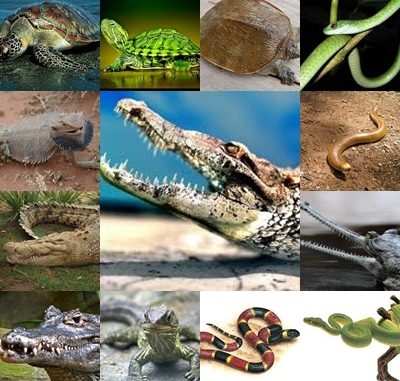
REPTILES
Scaly, creeping, cold-blooded reptiles can seem sinister — especially venomous snakes and snapping crocodiles. Yet many reptiles are glossy, vividly coloured creatures, with fascinating habits. Most are hunters, but since they do not use any energy keeping warm they do not need to eat much. Crocodiles often go for months without eating, and some big snakes can survive for a year on just one big meal.
CROCODILES The most powerful of all reptiles, alligators and crocodiles are ferocious predators that ambush, kill, and eat animals as big as zebras.
TUATARA Found only in New Zealand, the two species of tuatara are the only survivors of a group of reptiles that mostly died out 100 million years ago, during the age of dinosaurs.
GECKOS Special hairs beneath the broad toes of many geckos act like suckers, enabling these active, agile lizards to climb up any surface, including glass, and even run across ceilings.
CHAMELEONS Famous for their ability to change their skin colour, chameleons are slow-moving lizards that hunt by shooting out their very long, sticky tongues to catch insects.
VENOMOUS LIZARDS The Gila monster is one of just two species of lizard with a venomous bite. Both live in deserts in Mexico and the United States.
IGUANAS Iguanas are typical lizards – reptiles that usually have four legs, a long tail, and scaly skin. Most lizards eat small animals, but the green iguana is mainly vegetarian.
TURTLES Instantly recognizable by their shells, turtles and tortoises have existed since the days of the first dinosaurs. Tortoises are famously slow, but turtles can swim quite fast over long distances.
VIPERS Equipped with long poison fangs that hinge forwards when they open their mouths, vipers such as rattlesnakes are extremely dangerous. Luckily, rattlesnakes rattle their tails as a warning.
COBRAS Among the deadliest of venomous snakes, cobras are armed with a nerve poison that paralyzes their victims so they cannot breathe and they die from suffocation.
LEGLESS LIZARDS Some lizards have no legs, so they look and behave like snakes. The European glass lizard has tiny vestiges of legs, showing that its ancestors were like normal lizards.
COLUBRIDS Three-fifths of all snake species belong to the colubrid family. Most are harmless, but some, including the mangrove snake, have venomous fangs at the backs of their mouths.
PYTHONS Most of the biggest snakes are pythons — powerful, non-venomous reptiles that kill their prey by coiling around it and squeezing until it cannot breathe.
Picture Credit : Google




